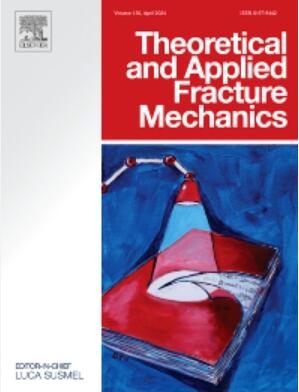Higher-order asymptotic solution of bi-material V-notch with dissimilar hardening coefficients under plane strain condition
IF 5
2区 工程技术
Q1 ENGINEERING, MECHANICAL
引用次数: 0
Abstract
In this study, the first two terms of the asymptotic expansion of the stress field at the corner of the interface of two elastic–plastic materials with dissimilar hardening coefficients have been extracted under plane strain conditions. The total deformation theory of plasticity and hardening behavior in the form of power law has been used to obtain the general stress–strain relationship. The eigenvalue and mode-mix parameter related to the first term and the second term of the stress expansion according to the angle of the material that has a higher hardening coefficient have been extracted for different hardening coefficients. Considering the first two terms, unlike the first term where the eigenvalue is not dependent on the properties of the material with the lower hardening coefficient, the eigenvalue of the second term may depend on the properties of both materials. To obtain the coefficients of the first term and the second term of the stresses obtained from the asymptotic solution, the root mean square (RMS) of the differences between the stresses obtained from the asymptotic solution and the finite element (FE) solution are minimized in the shear loading condition. The conformity of the results obtained from the asymptotic solution with the results obtained from the FE solution at different angles and for different hardening coefficients has been checked. The obtained results show that with the increase of the angle and the hardening coefficient of the material which has a higher hardening coefficient, the discrepancy between the results of the asymptotic solution and the FE solution increases, and as a result, the need for higher order terms increases. The greater difference mode-mix parameter of the two materials causes a greater difference between the asymptotic results and the FE results in the first material, and this discrepancy is reduced by considering higher-order terms.
求助全文
约1分钟内获得全文
求助全文
来源期刊

Theoretical and Applied Fracture Mechanics
工程技术-工程:机械
CiteScore
8.40
自引率
18.90%
发文量
435
审稿时长
37 days
期刊介绍:
Theoretical and Applied Fracture Mechanics'' aims & scopes have been re-designed to cover both the theoretical, applied, and numerical aspects associated with those cracking related phenomena taking place, at a micro-, meso-, and macroscopic level, in materials/components/structures of any kind.
The journal aims to cover the cracking/mechanical behaviour of materials/components/structures in those situations involving both time-independent and time-dependent system of external forces/moments (such as, for instance, quasi-static, impulsive, impact, blasting, creep, contact, and fatigue loading). Since, under the above circumstances, the mechanical behaviour of cracked materials/components/structures is also affected by the environmental conditions, the journal would consider also those theoretical/experimental research works investigating the effect of external variables such as, for instance, the effect of corrosive environments as well as of high/low-temperature.
 求助内容:
求助内容: 应助结果提醒方式:
应助结果提醒方式:


